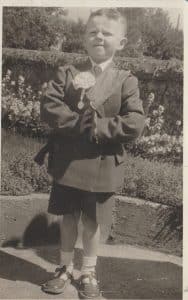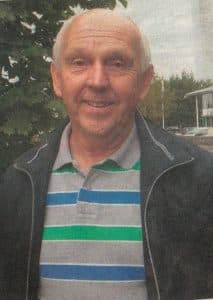PJ Rafferty’s mother Eileen was first brought to the Tuam Mother and Baby Home in 1951, aged 27. Pregnant outside of marriage, Eileen was discretely ushered into the home by the local parish priest, anxious to avoid a scandal in the Galway town.
In an era of a Catholic Ireland seemingly devoid of empathy, compassion or indeed Christianity, pregnancy outside of marriage was, as PJ points out, a crime “akin to murder”; under a patriarchal church, it was the women who were punished, filtered out and forgotten.
Although PJ’s memory of the home is fragile – a fact he puts down to something “terrible” having happened there, his experience of the home was that it shaped his childhood and teenage years and his brief relationship with his mother.
“When my mother got pregnant, rumours started flying around and somebody went down and told the priest; he came up to the house and told her that she wouldn’t be able to go to church any more, being pregnant outside of marriage.
He told her that it was a bad influence on all the people around the town and she’d be better off if she was kept indoors till such time the baby was due. Then he told her parents there was a place in Tuam where there were nuns who looked after women who had babies outside of marriage”.
PJ’s mother spent 12 months at the Bon Secours-run Mother and Baby Home before being forced to leave without her baby. The reason for staying those 12 months, according to PJ, was that the nuns were anxious for babies to be breastfed, because it would “save them the trouble of buying milk and that”, as well as the fact they could have the women work there, looking after other babies, cleaning and washing.
“My mother had to leave after 12 months because they didn’t want the bonding, so she had to get out; she said she wanted to bring the baby with her, and the nuns said ‘you’re not fit to keep him, he’s going to be kept here and fostered out’, and they closed the door on her face. So rather than leave Tuam, she got work in the town as a cleaner.
Every time she was off during the week she would take ten minutes and walk up to the home and knock on the door, pleading and begging with the nuns, ‘please hand out my son, please let me see him’, and they’d tell her to go away; she spent five and a half years doing that while I was there.

To think that my mother, if she had money, could buy me out of there, if she had money to give the nuns and say ‘here you are’. And I mean where were you supposed to get 100 pounds in those days? Sure you wouldn’t have it. And she could buy me. Jesus Christ, to think that you could buy your own baby”.
Although PJ finds it difficult to remember life in the home, he vividly remembers the mattresses leaning up against the home’s windows each day, drying out from where children had wet them. He also recalls the alienation he felt in school, where children from the home were treated differently to the other children:
“We were put in a room on our own and were cornered off in a section of the playground, and the nuns were watching you to make sure you weren’t playing with the other children. The other kids would be kicking around and playing their games and that.
We weren’t allowed to talk to the other children. We were kept away from them because a lot of the parents didn’t like us mixing with them. They had this thing of us maybe carrying diseases and that. We were filth, the dirt of the earth really and truly. That’s the way we were treated, like we were filthy dirty”.
PJ, Patrick Joseph – from Menlough in Ballinasloe – was fostered at six years of age and remembers walking to a car hand-in-hand with his foster mother. He recalls seeing a dog for the first time, and chickens and hens on his foster parents’ farm. Now 65, he has only fond memories of his foster parents, how “great” they were, and that only for them he doesn’t know where he would have been, that perhaps he would have killed himself.
When PJ was in his twenties, he discovered that his mother was living and working in England and, having received a letter from her, travelled to Brixton to meet her for the first time. In what was an emotional reunion, they chatted, exchanged stories and took photos, but although there was some contact afterwards, the letters eventually stopped. It would be 2010, after PJ’s foster parents passed away, before his mother wrote to him again, prompting him to travel with his wife back to Brixton unannounced.
“So then out of the blue we got a letter from my mother, and she said that her husband had died shortly after we’d seen her before in the 1970s. She said she didn’t want to interfere but could she become part of my life, part of my family.
We decided we’d go back then, but that we wouldn’t tell her, in case she mightn’t open the door, that she could be nervous. We decided to take a chance on it, so we got to Brixton and walked down the street where she was living, and we walked on the opposite side in case she was looking out and might see us and recognise me.
As it happened we saw this small elderly woman leaning on the wall, and we crossed the road over to her. She said ‘good morning’ and we said ‘good morning’ to her. We said we were looking for the new neighbours that moved in next door. I walked over to her and said ‘it’s maybe you I’m looking for, do you know who I am?’ She said: ‘I knew you across the street – the power is gone from my two legs…’. ‘It was a total shock’, she said, ‘I didn’t think I’d ever see you again’.

So we took her down to a little restaurant and we had a nice little chat. I was going to ask her about Tuam, but she sat across the table from me, and you’d want to see her face, you’d want to see her eyes, and you’d want to see the smile on her face. A photograph wouldn’t take it. I thought it would just break her heart if I asked her about Tuam, and I couldn’t get around to go asking her anything because I thought that would ruin it. I said I’d leave it with what I knew”.
PJ Arranged for his mother to meet her three grandsons, but when he came back to Brixton a year later, he was bitterly disappointed; when he met her – her grandsons having arranged flights to the UK – she didn’t recognise him:
“We went back and we knocked on the door, but got no answer; Eileen, my wife said ‘its coming up to six
o’ clock, she might be gone to mass’, so we went for a walk, hoping to see her. Eileen suddenly said ‘there’s your mother with the walking stick walking down towards the church’.
We crossed the road to her and I said ‘how are you mother?’, and she just said ‘I’m not your mother’. I said ‘I’m PJ, PJ from Galway, I’m your son – I met you a year ago and you said you wanted to meet your three grandsons’. All she said was ‘get away and leave me alone, I’ve no son’. That was an awful let down for me, it was a real heart break. So my wife said ‘let her off to mass, she’s confused’. It was only shortly after that that she passed away”.
On March 3 this year, the Commission of Investigation into Mother and Baby Homes announced that “significant amounts of human remains” had been found buried in a septic tank at the site of the Tuam Mother and Baby Home. The remains belonged to children aged from “about 35 foetal weeks to two to three years”. Forensic examinations of samples recovered there suggested that the remains dated “from the time-frame relevant to the operation of the Mother and Baby Home”.
According to the Commission, the remains had been discovered in a number of underground chambers in what appeared to be a ‘sewage-related structure’ on the site. In all, it was believed that 796 children had died at the home.
“I thought it was scandalous, absolutely, utterly scandalous, when I heard about a woman who was supposed to wrap those bodies up and bring them down through a tunnel and put them into a tank that was cleaned out, I couldn’t get over it for a Catholic country.”, says PJ.

“To think that those little babies may have died of neglect, I just couldn’t understand it. Why were they not taken into Galway hospital? Why were they not taken to a hospital in Tuam, where they could have been given some sort of chance, some medication, something? What sort of nuns were they?
What annoyed me more than anything, we had a main cemetery across the road, all they had to do was walk across to bury them, and I was just wondering if a priest was even called to anoint those babies when they died, were they even blessed?…So where’s your Christianity there?… God Almighty, they were thrown in there and not even a priest to come along and anoint them, or even bless the ground”.
Following the discoveries in March this year, PJ says he rang Enda Kenny’s office “a couple of times” to invite him down to Tuam to meet survivors, but received no reply. He then wrote to Michael D Higgins inviting him to speak, but again got no answer:
“I thought, surely to God, and them both being from the West of Ireland, that they’d have some decency and come down to meet us. God Almighty, they should have some respect for us and they don’t seem to be showing any respect. When I was asked what I thought about Enda Kenny’s speech on the Mother and Baby Home, I said ‘He was great, but he read it out of a newspaper’”.

What would PJ Like to see happening now?
“For me, what I would I’d love to see is the babies removed from there and buried in the main cemetery across the road in an Angels Plot. When they closed down the Bon Secours hospital in Tuam, they brought in new coffins for the nuns and took their remains and buried them below in Knock. I think the same respect should be given those babies.
I am annoyed, the way the church was run at that time and the way that some of the nuns had power, and how they abused that power. Surely to God, they went to mass in the church in the morning? What were they looking up at? If they were looking up at the crucifix of our Lord, they were supposed to carry out his work on Earth. What I can’t figure out is why the Bon Secours are keeping so quiet now, and have kept quiet all along”.
By Ken Phelan